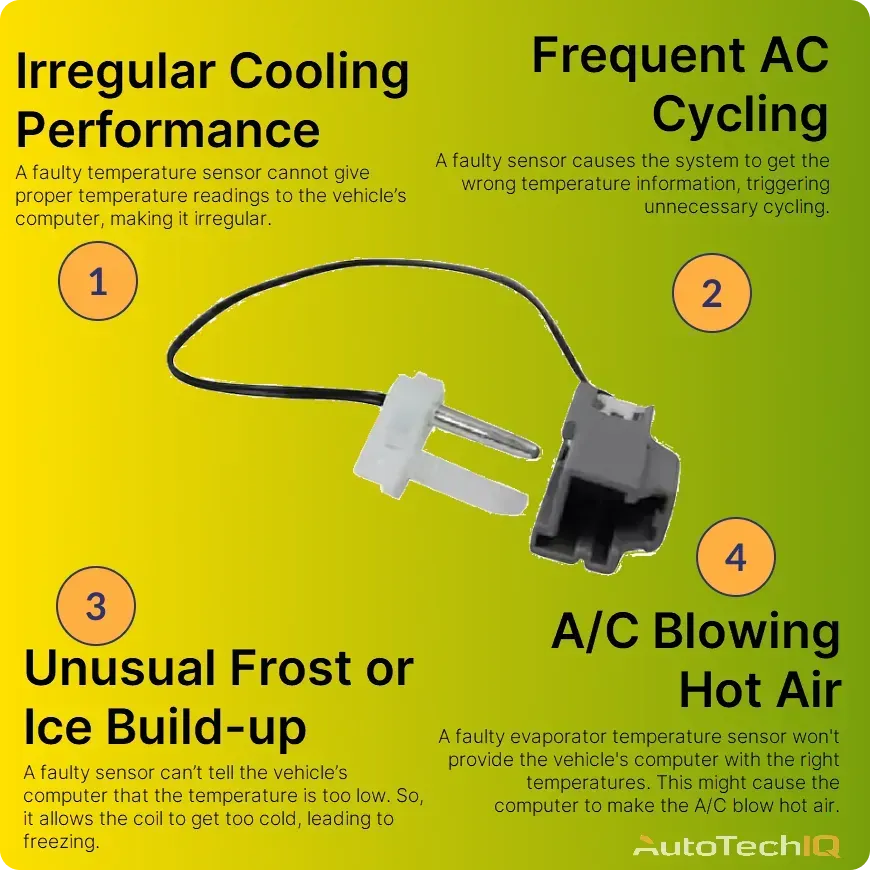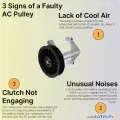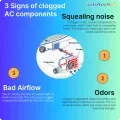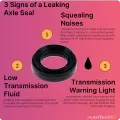
The evaporator temperature sensor is part of a vehicle's air conditioning system, and it's needed to prevent the AC evaporator from becoming too cold or too hot. Without this sensor, the AC evaporator won't know what the temperature is at, and your Air Conditioning becomes faulty.
- Where is it found? The evaporator temperature sensor is somewhere behind your dashboard, together with the internal air conditioning system.
This sensor reads the air temperature that passes through the evaporator; it reads the temperature to understand if the evaporator is getting too cold and if the temperature should increase to avoid it from freezing up.
- What is this AC Evaporator? It's a component inside your AC system that's designed to become very cold with the help of refrigerant fluid. After it's incredibly cold, it'll work with the other AC components to pass on this coldness to the air inside the car. The temperature sensor reads the temperature and warns if the evaporator is too cold or too warm, helping it stay in the right temperature spot.
So, the evaporator temperature sensor knows how cold the AC evaporator is? Yes. By knowing the current temperature, it'll know if the evaporator needs to get hotter or colder. If the temperature sensor is faulty, it won't know the temperature, and the evaporator will work blindly, risking it freezing up or becoming too hot.
If the evaporator gets too cold and freezes up, it can cause issues with the air conditioning system. A more technical way to say it would be that the sensor reads the temperature and sends the “number” to the car's computer system. Then, the computer adjusts the refrigerant flow according to the value, preventing freezing.
What problems can come out of a faulty evaporator temperature sensor?
- The car's AC can become too weak and warm.
- Wires, insulation, and other components inside the AC can overstress and burn, leading to smells like burning plastic.
- The AC temperature might always stay the same regardless of how you adjust it.
- If the evaporator sensor mistakenly tells the evaporator to increase temperature, the AC might start blowing hot air.
Can you drive with a broken temperature sensor?
Yes, but your vehicle’s AC won’t be cooling as you’d like. This sensor helps control the temperature of the air conditioner. So, if it malfunctions, the AC won’t cool properly. Additionally, the evaporator might freeze, causing further damage to the AC system. While it doesn’t make your car less safe or reliable to drive, it makes it less comfortable.
How do you fix an evaporator sensor error?
A technician will first diagnose the issue using specialized tools. If the sensor is faulty, they'll access it near the AC unit's evaporator coil and replace it with a new one. This replacement usually happens fast. However, if the problem had spread out, there might be extra repairs to the surrounding components.

Where is the evaporator coil sensor located?
The evaporator coil sensor is near or on the evaporator coil itself, which is part of your vehicle's air conditioning system. Usually, you'll find this coil and the attached sensor within the dashboard or under the glove compartment. The exact location can vary depending on the make and model of your vehicle. The evaporator coil sensor placement is crucial for monitoring the temperature of the passing air accurately.

How do I know if my AC temperature sensor is bad?
A faulty AC temperature sensor has telltale signs; keep an eye out for irregular cooling, where the air conditioning doesn't keep a steady temperature, and bad cycling patterns, with the AC turning on and off frequently. Modern cars may display dashboard warnings showing sensor issues. Additionally, if you see frost build-up in the AC unit, the sensor is faulty. These symptoms warrant a professional check-up to diagnose and resolve the problem.
Do I need to replace the AC temperature sensor?
If it’s faulty, yes. A faulty sensor causes bad cooling and can stress other AC components. Plus, there isn’t a repair method for this sensor; the common way around it is replacement. Professional diagnosis is essential to confirm the issue. Once confirmed, replacing the sensor should deal with the issue and restore comfort to your car.
What are the common symptoms a driver may notice
-
Inconsistent Cooling Performance: The AC may stop blowing cool air repetitively or not cool enough. This is because a faulty temperature sensor cannot give proper temperature readings to the vehicle’s computer, making it irregular.
-
Frequent AC Cycling: The AC system turns on and off more often than usual. A faulty sensor causes the system to get the wrong temperature information, triggering unnecessary cycling. In some cases, the A/C might start blowing hot air.
-
Unusual Frost or Ice Build-up: You might notice frost or ice in some AC components, particularly around the evaporator coil. This happens because a faulty sensor can’t tell the vehicle’s computer that the temperature is too low. So, it allows the coil to get too cold, leading to freezing.

What does a proper evaporator temperature sensor service look like
A certified shop believes in educating car owners about their vehicle's problems and needs. For A/C-related issues, the practice remains the same, especially for intricate services like evaporator temperature sensor replacement.
To have a better understanding of how AutoTechIQ-certified shops perform their service, let’s analyze an event based on actual field experience between the customer and the technician.
Inspect: A customer, Mr. Jensen, brought in his car complaining about inconsistent AC cooling. The technician, Sarah, looked around the AC system, focusing on the evaporator area. She used a small camera to photograph her findings in the evaporator coil and sensor area. These images captured signs of corrosion and wear. Then, Sarah showed the customer these images, explaining that such damage can affect AC functioning.
Test: Next, Sarah did a diagnostic test. She connected a scan tool to Mr. Jensen’s car to read any fault codes about the AC system. Some fault codes appeared, confirming the issue was with the evaporator temperature sensor.
Evaluate: Sarah explained to Mr. Jensen how the faulty sensor caused his AC's issues. She used images and videos showing how a working sensor keeps good temperatures and prevents issues like freezing or overworking the system.
Diagnose: With the inspection and test results, Sarah diagnosed that the sensor needed replacement. To explain her diagnosis better, she showed Mr. Jensen an image comparison between his temperature sensor and a new one, highlighting the differences.
Confirm Repair: After replacing the sensor, Sarah did a final test to confirm everything was working correctly. She invited Mr. Jensen to see the now-working A/C, showing him the stable temperature readings on the diagnostic tool. She also showed how the AC was cooling better.
Through this process, Mr. Jensen got his car fixed while understanding the role of an evaporator temperature sensor and appreciating the thoroughness of Sarah's approach.
Top 5 Causes of Evaporator Temperature Sensor Issues
Sensor Wear and Tear: Over time, the sensor can worsen due to everyday use, leading to wrong temperature readings and irregular cooling in the AC system.
Corrosion: Moisture and chemicals can cause the sensor to rust, affecting its ability to accurately measure and control the evaporator's temperature.
Loose or Faulty Wiring: Wiring issues, like loose connections or damaged wires, can interfere with the sensor's function, resulting in broken AC function and temperature changes.

Dirt and Debris Accumulation: Dirt or debris on the sensor can block its ability to detect the correct temperature, causing the AC system to underperform or cool too much.
System Refrigerant Issues: Low or leaking refrigerant in the AC system can affect the sensor's operation, as the temperature changes aren't consistent with the system's design specifications. If the cooling system has issues, the engine might also overheat.
Top 5 evaporator temperature sensor Fixes
Sensor Replacement: Replace the faulty sensor with a new one to confirm accurate temperature and consistent AC performance.
Wiring Repair: Fix or replace any damaged or loose wiring connected to the sensor to restore electrical connections and sensor functionality.
Cleaning the Sensor: Remove any dirt or debris from the sensor to improve its accuracy in detecting and regulating the AC system's temperature.

Refrigerant Recharge: Refill the AC system's refrigerant to the correct level, ensuring the sensor operates under good conditions.
Corrosion Treatment: Clean or replace corroded parts, including the sensor, to prevent malfunctions and keep the efficiency of the AC system.
Summary
This article explores common issues and solutions about the evaporator temperature sensor in car AC systems. It highlights symptoms like unstable cooling, frequent cycling, and frost build-up, often caused by sensor wear, corrosion, wiring problems, debris, or refrigerant issues. Effective fixes include sensor replacement, wiring repair, cleaning, refrigerant recharge, and addressing corrosion. The article emphasizes the importance of timely diagnosis and repair to maintain optimal AC performance and prevent further system damage.
There's an auto shop near you delivering fair, transparent service like you've read here.
Feel free to visit our 'Shop Near You' page and search for our certified repair shops in your area. These businesses provide top-notch services and expert inspections using advanced diagnostic tools. You'll witness the same level of care and attention to detail highlighted in this article. These shops share our goal of ensuring your vehicle receives the best possible maintenance. At this goal's core, your knowledge of what's happening to your car and how to maintain it is our #1 priority.
Other news
-
Car is Squealing When Driving

-
What is Preventative Maintenance and What Are The Benefits of it?

-
JobViewIQ - DVI Process Training - Part of the Auto Care Alliance Benefits

-
7 Signs of AC Pulley Issues

-
7 Signs of Clogged AC Components

-
How Much Does a Transmission Fluid Change Cost?

-
7 Signs of a Leaking Axle Seal
